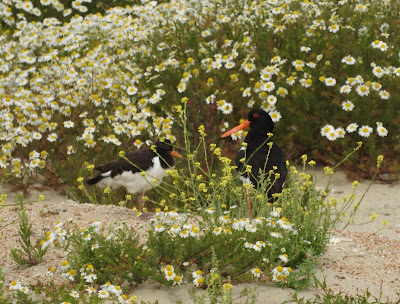New Romney - warm, dry and sunny, SW4 - Having neglected the local farmland of late we decided to walk our normal routes around the town over the weekend where the Marsh landscape is predominantly brown and the grain harvest is starting to kick in. As is the norm in mid-summer bird song is mainly reduced to the hour around dawn, after which most species are either busily feeding juveniles or going into moult; while migrants are preparing for the long haul south with some, such as Cuckoo and Swift already gone. Looking at the warblers first, Blackcaps appear to buck the go-slow trend and are still in reasonably good voice in copses and parks hereabouts, in contrast to Common and Lesser Whitethroats, Cetti`s and Reed Warblers which have largely fallen silent, apart from their persistent contact calls, while the first passage Willow Warblers have been heard along Hope Lane. House Martins are nesting in at least three locations across the town, but only in small numbers, although Swallows appear to have done well with many fledged birds on wires and fences around stables and outbuildings along with a scattering of Pied Wagtails and plenty of House Sparrows (but nothing like the thousands we used to get around the Hertfordshire village of my youth in the 1960`s). Home spun farmland birds are in very short supply though with only a few pairs of Linnets, Chaffinches and Reed Buntings; a pair or two of Yellowhammers and Greenfinches in Hope Lane; two of Corn Bunting and one of Yellow Wagtail on the Salts and a sprinkling of Skylarks overhead. Poor fare then, but to be expected, considering the industrial-scale arable farming on the Marsh; infact its a minor miracle anything can survive in such a hostile environment. As for non-passerines, Stock Doves and Woodpigeons are commonplace, Green Woodpeckers appear to have done well and the hooked-beak brigade of Kestrel, Buzzard and Sparrowhawk have all produced fledged young. Further afield a couple of visits to the bird reserve yesterday at Dengemarsh and ARC produced the usual suspects, the highlight being a cracking adult Turnstone in breeding plumage from Hanson hide alongside the plovers and sandpipers.

Hope Lane, NR
At the micro-level there has been some excitement this past week around the garden with regular bat sightings at dusk, mostly from pipistrelle types but also once or twice from a much larger beast, probably a Noctule, although a bat detector would be required to confirm the identities. New moths have been lured to light with a Pebble Hook-tip the pick of the past two nights. The buddleia bushes are starting to attract a few precious butterflies, including a cracking Comma the other day, but they really are low in both number and variety. Yesterday evening I was roused from a post gin and tonic slumber by a horrible shrieking out front, and then from the back. At first I thought it was just the local teenage hoodlums, but as I tottered out into the garden the avian equivalent hurtled over again - a damn, great, green parakeet! And to complete this weeks garden safari we`ve had a nocturnal Hedgehog visitation, judging from the presence of some very distinctive droppings...

.JPG)
.JPG)
.JPG)
.JPG)
.JPG)
.JPG)
.JPG)










.JPG)
.JPG)
.JPG)
.JPG)
.JPG)
.JPG)
.JPG)
.JPG)
.JPG)
.JPG)
.JPG)
.JPG)
.jpeg)
.JPG)
.JPG)

.JPG)

.JPG)
.JPG)
.JPG)
.JPG)
.JPG)
.JPG)
.JPG)




.JPG)
.JPG)
.JPG)
.JPG)
.JPG)
.JPG)
.JPG)